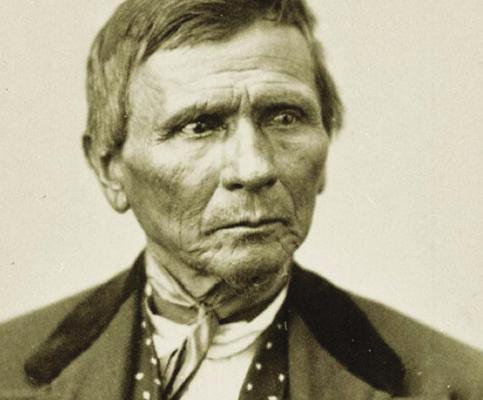Studying the life of a man
A tombstone that depicts two hands shaking in compromise reads, “In remembrance of Black Beaver. Died May 8, 1880. Aged 74 years.” Black Beaver’s life is a story of triumph, exile and service to country.
Much of the legacy of the Lenape people of Oklahoma can be learned by studying the life of a man who is buried at the Fort Sill Post Cemetery in Lawton.
Lenape [Leh-NAH-pay] translates to “the people” and is a distinction detailing the ancestry of the Delaware Tribe of Indians.
According to tribal historical documents, Black Beaver [Suck-tum-mah-kway] played a role in the success of the Civil War for the Union army and was vital to the survival of the Delaware Tribe. Before the Southern states ceded from the Union in 1861, he was a scout, interpreter of more than 11 languages and chief of the Delaware people. He was a revered employee of the American Fur Company, a business known to hire indigenous people to navigate through uncharted territories.
In 1834, Black Beaver enlisted himself and other indigenous volunteers to fight alongside the Americans in the Mexican-American war.
“Black Beaver served as an interpreter and a guide on the American side,” said Wesley Boone, who works in public relations for the Delaware Nation. “He provided guidance for a people, at the time, that looked down on him as a lesser.”
After the war, Black Beaver built and settled in a cabin in Caddo County that still can be seen by visitors.
On April 12, 1861, the United States separated into a Civil War that often left tribes caught in the middle. Black Beaver, now a Delaware chief, once again took up arms with the Union soldiers and acted as a Native American dignitary and scout.
“Black Beaver was pivotal to the success of the Civil War on the western side,” said Nekole Alligood, a Native American Graves Protection Act representative. “He helped negotiate peace with the various indigenous tribes and maintained order while the Union soldiers fought the Confederacy.”
Black Beaver worked as a guide to escort troops from Fort Cobb to Kansas. In retaliation, according to the Delaware Nation Cultural Preservation Department, Confederate soldiers seized his cattle and burned his farm. Until his death, Black Beaver petitioned the U.S. government to compensate the Lenape people for damages during the war. No compensation has been given.
After the war ended, the Delaware faced a new struggle: forced migration.
Between 1866 and 1867, tribal leaders were forced to sign treaties effectively relocating the tribe from Kansas to northern Oklahoma within the Cherokee Nation boundaries.
“The Lenape people were given two choices: relinquish citizenship to the Cherokee and live in current-day Bartlesville, or pay an extra fine to the U.S. government and move further south,” Boone said. “Black Beaver made his choice and moved with a small band of Delaware.”
The larger Delaware Tribe remained in northeast Oklahoma with its headquarters in Bartlesville, and the Delaware Nation relocated to Anadarko.
Even after the removal, Black Beaver worked with the United States as a peace negotiator.
“Our ancestors were known as the grandfathers,” Alligood said. “We wanted peace, first and foremost. We may not have been given it but they wanted to be a calming, united clan among the other indigenous tribes.”
In 1880, Black Beaver died in Anadarko where he was put to rest. In 1975, his body was reburied at Fort Sill to commemorate his service to the United States. He was the first person inducted into the Indian Hall of Fame in Anadarko.
The Lenape culture has felt the strains of time and generational change. Traditions begin to fall short and language fades, members say. But measures have been taken to preserve the culture.
In 2018, the Delaware Tribe Historic Preservation Office, led by Cultural Director Curtis Zunigha, implemented the Lenape Language Project.
“Our last fluent speaker died a few years ago,” Zunigha said. “What we wanted to ensure was that our history, our people had something from our ancestors to keep our tribe thriving.”
The Cultural Center in Bartlesville applies the practice with a Lenape word of the day.
Many of the words are considered basic: cat, help me, and goodbye (In Lenape: pushis, wichemi, and Lapich Knewel). According to the tribal website, there are more than 15,000 words and counting being studied in the language program.
“A culture is nothing without the words to convey meaning,” Zunigha said. “What we decided to do was start with educating the children and, through our teachings, maybe they will spread our history and allow it to grow.”
The language program has proven promising. According to the tribal newspaper, Delaware Indian News, the program boasts 12 children who participate in ritual ceremonies rooted in Delaware history.
Zunigha finds this a hopeful sign.
“Perhaps, in some way, we can grow our cultural awareness and have historians of our own tell the story of our people; through our eyes, not through the means of people who know nothing of us.”
Brandon King is a reporter with Gaylord News, a reporting project of the University of Oklahoma Gaylord College of Journalism and Mass Communication.

